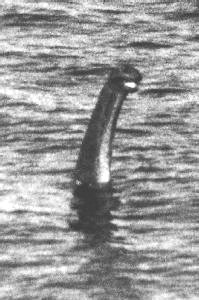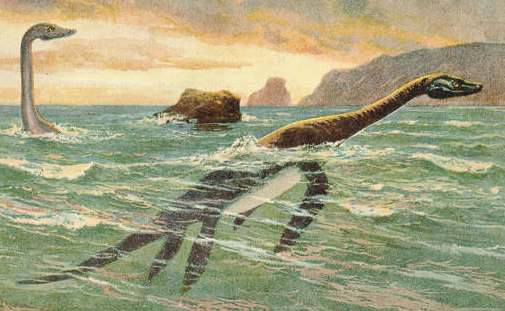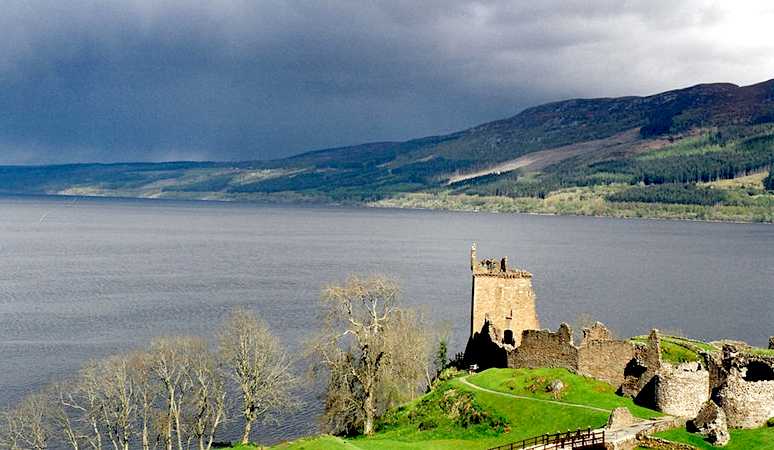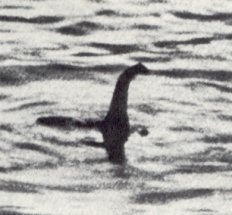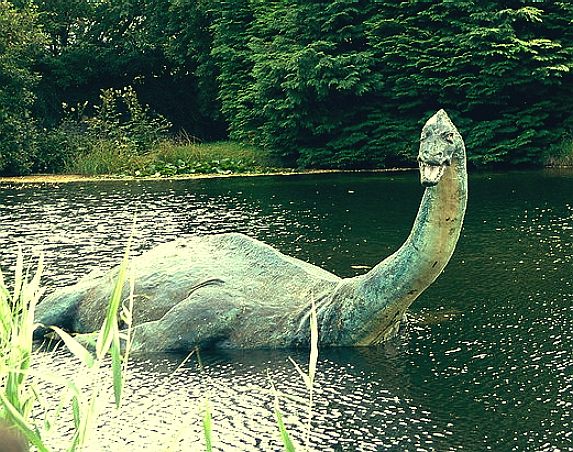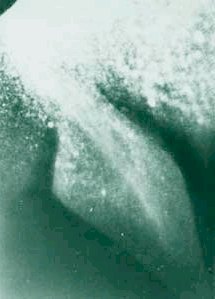|
THE LOCH NESS MONSTER
|
||||||||||||||||||||||||||||||||||||||||||||
|
HOME | BIOLOGY | BOOKS | FILMS | GEOGRAPHY | HISTORY | INDEX | INVESTORS | MUSIC | NEWS | SOLAR BOATS | SPORT |
||||||||||||||||||||||||||||||||||||||||||||
|
Could a prehistoric creature actually be living in a lake in Scotland? Loch Ness is certainly large enough and deep enough. It is 24 miles long by about a mile across. It has a mean depth of 433 feet, twice that of the North Sea into which it flows through the River Ness at its eastern end. Five rivers and 50 mountain streams feed Loch Ness. The loch never freezes, and snow rarely lies near its shores. Its temperature remains fairly constant at about a chilling 42 degrees Fahrenheit, summer or winter.
A picture of the alleged Loch Ness Monster taken from Urquhart Castle on May 21 1977
The Loch Ness Monster is a mysterious and unidentified animal, claimed to inhabit Scotland's Loch Ness, the most voluminous freshwater lake in Great Britain. Along with Bigfoot and the Yeti, the Loch Ness Monster is one of the best-known mysteries of cryptozoology. Most scientists and other experts find current evidence supporting the creature's existence unpersuasive, and regard the occasional sightings as hoaxes or misidentification of known creatures or natural phenomena. However, belief in the legend persists around the world, with the most popular theory posing that the creature is actually a plesiosaur.
Name
The creature's disputed "scientific" name, chosen by the late Sir Peter Scott, is Nessiteras rhombopteryx (Greek for "the wonder of Ness with the diamond shaped fin"), although skeptics note the name to be an anagram of "Monster hoax by Sir Peter S". The name is also anagrammatic of "Yes both pix are monsters-R", the 'R' referring to monster hunter Robert Rines.
The local Scottish highlanders, and indeed many people around the world, have affectionately referred to the animal by the feminine name of Nessie.
Description of Nessie
Many explanations have been postulated over the years to describe what kind of animal the Loch Ness Monster might be:
Plesiosaurs, by Heinrich Harder, 1916
Plesiosaur
The most common eyewitness description of Nessie, is that of a plesiosaur, a long-necked aquatic reptile that became extinct during the Cretaceous-Tertiary extinction event. Supporters of the plesiosaur theory cite the survival of a fish called the coelacanth, which supposedly went extinct along with the plesiosaur but was rediscovered off the coast of Madagascar in 1938.
On the other hand, mainstream science does offer plausible reasons why such an animal could not exist in Loch Ness. Apart from its apparent extinction, the plesiosaur was probably a cold-blooded reptile requiring warm tropical waters, while the average temperature of Loch Ness is only about 5.5°C (42°F). Even if the plesiosaurs were warm-blooded (like dinosaurs), they would require a food supply beyond that of Loch Ness to maintain the level of activity necessary for warm-blooded animals.
Moreover, there is no substantive evidence in the bone structure of fossilized plesiosaurs that indicate sonar capability (similar to that possessed by dolphins and whales). Such a system would be necessary in the loch, as visibility is limited to less than 15 feet due to a high peat concentration in the loch. Consequently, sunlight does not deeply penetrate the water, limiting the amount of photosynthetic algae, thereby reducing the number of plankton and fish in the food chain. Fossil evidence indicates plesiosaurs were sight hunters, it is unlikely that the loch's peat-stained water would allow such animals to hunt the limited food supply at sufficient levels.
In October 2006, Leslie Noè of the Sedgwick Museum in Cambridge pointed out that, "The osteology of the neck makes it absolutely certain that the plesiosaur could not lift its head up swan-like out of the water", precluding the possibility that Nessie is a plesiosaur.
Kelpie
According to the Swedish naturalist and author Bengt Sjögren (1980), present day beliefs in lake monsters such as "Nessie" are associated with the old legends of kelpies. He claims that the accounts of lake monsters have changed over the ages, originally describing a horselike appearance, but in recent times describing a stronger resemblance to dinosaurs or plesiosaurs. Sjögren concludes that the kelpie legends have developed into more plausible descriptions of lake monsters, reflecting awareness of plesiosaurs. In other words, the kelpie of folklore has been transformed into a more "realistic" and "contemporary" notion of the creature. Believers counter that long-dead witnesses could only compare the creature to that which they were familiar -- and were not familiar with plesiosaurs.
Long-necked seal
Peter Costello posed the theory that Nessie and other reputed lake monsters were actually an unknown species of long-necked seal. This theory is supported by several sightings of the monster on land, during which the creature supposedly waddled into the loch upon being startled, in the manner of seals and sea lions. However, all known species of pinnipeds are usually visible on land during daylight hours to sunbathe, something that Nessie was never known to do.
Elephant
A theory presented by Neil Clark, the curator of paleontology at the Hunterian Museum in Glasgow has suggested that Nessie could merely be a swimming elephant, as there was a traveling circus passing through the area during the heyday of the sightings.
Eel
Some have theorized that "Nessie" could actually be a large eel. There are those who believe that an eel might have grossly enlarged in order to eat the bigger fish, or that a larger eel species inhabits the loch. But an eel could not protrude swanlike from the water as described in various sightings.
Other animals
Some theorists attribute the monster sightings to large pike (Esox lucius), sturgeon, dolphins, dogs (as in "The Spray Photograph"), otters, birds, and large molluscs (such as a large cephalopod or nematode).
Other explanations
Trees
In a 1982 series of articles for New Scientist, Dr Maurice Burton proposed that sightings of Nessie and similar creatures could actually be fermenting logs of Scots pine logs rising to the surface of the loch's cold waters. Initially, a rotting log could not release gases caused by decay, due to high levels of resin sealing in the gas. Eventually, the gas pressure would rupture a resin seal at one end of the log, propelling it through the water -- and sometimes to the surface. Burton claimed that the shape of tree logs with their attendant branch stumps closely resemble various descriptions of the monster.
Four Scottish lochs are very deep, including Morar, Ness and Lomond. But not all lochs have monster legends; the lochs with pinewoods on their shores have the legends, but Loch Lomond -- the one with no pinewoods -- does not. Gaseous emissions and surfactants resulting from the decay of the logs can cause the foamy wake reported in some sightings. Indeed, beached pine logs showing evidence of deep-water fermentation have been found. On the other hand, there are believers who assert that some lakes do have reports of monsters, despite an absence of pinewoods. (A notable example would be the Irish lough monsters).
Loch Ness, Scotland
Seiches and boat wakes
Loch Ness, due to its long, straight shape, is subject to some unusual occurrences affecting its surface. A seiche is a large, regular oscillation of a lake, caused by a water reverting to its natural level after being blown to one end of the lake. The impetus from this reversion continues to the lake's windward end and then reverts back. In Loch Ness, the process occurs every 31.5 minutes.
Boat wakes can also produce strange effects in the loch. As a wake spreads and divides from a boat passing the centre of the loch, it hits both sides almost simultaneously and deflects back to meet again in the middle. The movements interact to produce standing waves that are much larger than the original wake, and can have a humped appearance. By the time this occurs, the boat has passed and the unusual waves are all that can be seen.
However, there are wake sightings which appear to contradict the theory, as there are wakes that occur when the loch is dead calm with no boat nearby. A bartender named David Munro claims to have witnessed a wake which he believed to be a creature zigzagging, diving and reappearing. (There were 26 other witnesses from a nearby car park). Some sightings describe the onset of a V-shaped wake, as if there were something underwater. Moreover, many wake sightings describe something not conforming to the shape of a boat.
History of alleged sightings
Rumors of a huge animal living in the loch have existed for centuries. Some believers have argued that a lengthy history of monster sightings in the loch provides ample circumstantial evidence of the creature's existence. Others question the accuracy of such tales, and argue that they were generally unknown before the early 1960s when a strong wave of interest focused on the first clear examples of Nessie sightings in the 1930s. For example, an alleged sighting in October 1871 by a "D. Mackenzie", who supposedly described seeing something that moved slowly before moving off at a faster speed, has been repeated in several places, no original 1871 source for this report has been discovered, indicating that it may be an invention.
There have been far too many sightings to list in a single article. Many were questionable due to distance or other poor conditions; some sightings are cases of misidentified deer or boat wakes, and of course, there have been several hoaxes. There are some sightings, however, which cannot be easily explained.
Saint Columba (565)
The earliest known report occurred in the Life of St. Columba by Adamnan, written around the 7th century. It describes how in 565 Columba saved the life of a Pict, who was being supposedly attacked by the monster. Adamnan describes the event as follows:
Skeptics question the reliability of the Life of St. Columba as evidence for the Loch Ness Monster's existence, noting that the book describes implausible events, such as an incident when Columba slays a wild boar by the power of his voice alone. They argue that the monster encounter is said to have occurred on the River Ness, not in the Loch, and that Adamnan reports Columba encountering and conquering assorted "monsters" at various locations in Scotland, throughout his life. Moreover, skeptics assert that there are no other accounts of the Loch Ness monster attacking anyone, as the creature is normally portrayed as shy. In fact, biographies of the early saints were often embellished or invented for purposes of religious persuasion rather than historical record.
Land sightings
Although sightings of the creature on land around the loch reputedly date back to the sixteenth century, modern interest in the monster was sparked by a 22 July 1933 sighting, when Mr George Spicer and his wife saw 'a most extraordinary form of animal' cross the road in front of their car. They described the creature as having a large body (about 4 feet high and 25 feet long), and long, narrow neck, slightly thicker than an elephant's trunk and as long as the 10-12 foot width of the road; the neck had a number of undulations in it. They saw no limbs because of a dip in the road obscuring the animal's lower portion. It lurched across the road towards the loch some 20 yards away, leaving only a trail of broken undergrowth in its wake.
On 5 January 1934 a motorcyclist called Arthur Grant claimed to have nearly hit the creature while approaching Abriachan on the northeastern shore, at about 1 am on a moonlit night. Grant saw a small head attached to a long neck; the creature saw him and crossed the road back into the loch. Grant dismounted and followed it to the loch, but only saw ripples where it had entered.
In another 1934 sighting, a young maidservant named Margaret Munro supposedly observed the creature for about 20 minutes. It was about 6:30 am on 5 June, when she spotted it on shore from about 200 yards. She described it as having elephantlike skin, a long neck, a small head and two short forelegs or flippers. The sighting ended when the creature reentered the water.
Sporadic land sightings continued until 1963, when a poor-quality film of the creature was made from a distance of several miles.
Sightings in the loch
In May 1943, CB Farrel of the Royal Observer Corps was supposedly distracted from his duties by a Nessie sighting. He was about 250 yards away from a large-eyed, 'finned' creature, which had a 20-30 foot long body, and a neck that protruded about 4-5 feet out of the water.
In December 1954 a strange sonar contact was made by the fishing boat Rival III. The vessel's crew observed sonar readings of a large object keeping pace with the boat at a depth of 480 feet. It was detected travelling for half a mile in this manner, before contact was lost.
Three sightings in one night
On June 17, 1993, Edna MacInnes and David Mackay, both of Inverness, reportedly saw the monster which they described as forty feet long, pale brown, and with a long neck held high above the water. After swimming along the surface, it sank into the water. Although the monster was a mile from the shore, MacInnes claimed to have run along the shore to keep up with it. "I was scared when the wash from its wake lapped on the shore, but I just kept running behind it. By the time it plunged below the surface I was running as fast as I could go," She added. Forty minutes later they saw it again, and Mackay attempted to take a photograph, but only managed to get a picture of its wake.
Later the same evening it was reportedly seen by James MacIntosh of Inverness along with his son James. Young James saw it first, saying "Dad, that's not a boat." They described a pale brown, long-necked creature heading away from shore.
The final sighting of the night was reported by Lorraine Davidson, who saw a large wake in the loch, when no boats were visible for miles. The wake appeared to be different from a typical boat wake, in a manner not described in the report.
The 'Surgeon's Photo'
Photographs and films
The 'Surgeon's Photo'
One of the most iconic images of Nessie is known as the 'Surgeon's Photograph' which many consider to be good evidence of the monster, though doubts about the photograph's authenticity have been expressed. The photographer, a gynecologist named Robert Kenneth Wilson, never claimed it to be a picture of the monster. He merely claimed to have photographed "something in the water". The photo is often cropped to make the monster seem huge, while the original un-cropped shot shows the other end of the loch and the monster in the centre. The ripples on the photo fit the size and circular pattern of small ripples as opposed to large waves when photographed up close. Skeptics in the 1980s argued the photo was that of an otter or a diving bird, but after Spurling's confession agree it was what Spurling claimed - a toy submarine with a sculpted head attached.
Analyses of the original un-cropped image have fostered further doubt. Just a year before the hoax was ostensibly revealed, the makers of Discovery Communications's documentary Loch Ness Discovered did an analysis of the un-cropped image and found a white object evident in every version of the photo, implying that it was on the negative. "It seems to be the source of ripples in the water, almost as if the object was towed by something.", the narrator said. "But science cannot rule out it was just a blemish on the negative," he continued. Additionally, analysis of the full photograph revealed the object to be quite small, only about two to three feet long.
Some believe the photo to be a hoax in light of Chris Spurling's unrecorded deathbed confession allegedly witnessed by a reporter. Spurling was the son-in-law of Marmaduke Wetherell, a big game hunter who was deceived into searching for the storied Loch Ness monster based on evidence which turned out to be a children's prank. Wetherell was publicly ridiculed in the Daily Mail, the journal which employed him. Spurling claimed that to get revenge, Marmaduke Wetherell committed the hoax, with the help of Chris Spurling (a sculpture specialist), his son Ian Marmaduke, who bought the material for the fake Nessie, and Maurice Chambers (an insurance agent), who would call to ask surgeon Robert Kenneth Wilson to display the pictures. However, Spurling's "confession" is held in doubt because of the involvement of several people not connected to Wilson.
The Taylor film (1938)
In 1938 Mr GE Taylor, a South African tourist, filmed something in the loch for three minutes on 16mm colour film, which is now in the possession of Dr Maurice Burton. However, Dr Burton has refused to show the film to Loch Ness investigators (such as Peter Costello or the Loch Ness Investigation Bureau). A single frame was published in his book 'The Elusive Monster'; before he retired. Dr Roy P Mackal, a respected biologist and cryptozoologist, declared the frame to be "positive evidence." (Janet and Colin Bord, 'Alien Animals' (Granada 1986) p18)
The Dinsdale Film (1960)
In 1960, aeronautical engineer Tim Dinsdale filmed a hump crossing the water in a powerful wake unlike that of a boat. JARIC declared that the object was "probably animate".[2] Others were skeptical, saying that the "hump" cannot be ruled out as being a boat and claimed that when the contrast is turned up too high a man can be clearly seen in a boat. Some have questioned this, because the version they were watching was a pirate copy. This copy may itself have been a fake attempt to imitate the original.
In 1993 Discovery Communications made a documentary called Loch Ness Discovered that featured a digital enhancement of the Dinsdale film. A computer expert who enhanced the film noticed a shadow in the negative which was not very obvious in the positive. By enhancing and overlaying frames, he found what appeared to be the rear body, the rear flippers, and 1-2 additional humps of a plesiosaur-like body. He said that: "Before I saw the film, I thought the Loch Ness Monster was a load of rubbish. Having done the enhancement, I'm not so sure". Some have countered this finding by saying that the angle of the film from the horizontal along with sun's angle on that day made shadows underwater unlikely . Believers (and some nonbelievers) claim the shape could have been undisturbed water that was only coincidentally shaped like a plesiosaur's rear end. But the same source also says that there might be a smaller object (hump or head) in front of the hump causing this. Nonetheless, the enhancement did show a smaller second hump and possibly a third hump.
Searches for the monster
The LNPIB sonar study (1967-8)
Professor DG Tucker, chairman of the Department of Electronic and Electrical Engineering at the University of Birmingham, England, volunteered his services as a sonar developer and expert at Loch Ness in 1968. The gesture was part of a larger effort helmed by the Loch Ness Phenomena Investigation Bureau (LNPIB) from 1967-1968 and involved collaboration between volunteers and professionals in various fields. Tucker had chosen Ness as the test site for a prototype sonar transducer with a maximum range of 800 meters. The device was fixed underwater at Temple Pier in Urquhart Bay and directed towards the opposite shore, effectively drawing an acoustic 'net' across the width of Ness through which no moving object could pass undetected. During the two-week trial in August, multiple animate targets six meters (20 ft) in length were identified ascending from and diving to the loch bottom. Analysis of diving profiles ruled out air-breathers because the targets never surfaced or moved shallower than midwater. A brief press release by LNPIB and associates touched on the sonar data and drew to a close the 1968 effort:
Andrew Carroll's sonar study (1969)
In 1969 Andrew Carroll, field researcher for the New York Aquarium in New York City, proposed a mobile sonar scan operation at Loch Ness. The project was funded by the Griffis foundation (named for Nixon Griffis, then a director of the aquarium). This was the tail-end (and most successful portion) of the LNPIB's 1969 effort involving submersibles with biopsy harpoons. The trawling scan, in Carroll's research launch Rangitea, took place in October. One sweep of the loch made contact with a strong, animate echo for nearly three minutes just north of Foyers. The identity of the animal remains a mystery. Later analysis determined that the intensity of the returning echo was twice as great as that expected from a 10 foot pilot whale. Calculations placed the animal's length at 20 feet.
Submersible investigations
Earlier submersible work had yielded dismal results. Under the sponsorship of World Book Encyclopedia, pilot Dan Taylor deployed the Viperfish at Loch Ness on 1 June 1969. His dives, though treacherous and plagued by technical problems, were routine, and produced no new data. The Deep Star III built by General Dynamics and an unnamed two-man submersible built by Westinghouse were slated to sail but never did. It was only when the Pisces arrived at Ness that the LNPIB obtained new data. Owned by Vickers, Ltd., the submersible had been rented out to produce a Sherlock Holmes film featuring a dummy Loch Ness Monster. When the dummy monster broke loose from the Pisces during filming and sank to the bottom of the loch, Vickers executives capitalized on the loss and 'monster fever' by allowing the sub to do a bit of exploring. During one of these excursions, the Pisces picked up a large moving object on sonar 200 feet ahead and 50 feet above the bottom of the loch. Slowly the pilot closed to half that distance but the echo moved rapidly out of sonar range and disappeared.
The Big Expedition of 1970
During the so-called "Big Expedition" of 1970, Roy Mackal, a biologist who taught for 20 years at the University of Chicago, devised a system of hydrophones (underwater microphones) and deployed them at intervals throughout the loch. In early August a hydrophone assembly was lowered into Urquhart Bay and anchored in 700 feet of water. Two hydrophones were secured at depths of 300 and 600 feet. After two nights of recording, the tape (sealed inside a 55 gallon steel drum along with the system's other sensitive components) was retrieved and played before an excited LNPIB. "Bird-like chirps" had been recorded, and the intensity of the chirps on the deep hydrophone suggested they had been produced at greater depth. In October "knocks" and "clicks" were recorded by another hydrophone in Urquhart Bay, indicative of echolocation. These sounds were followed by a "turbulent swishing" suggestive of the tail locomotion of a large aquatic animal. The knocks, clicks and resultant swishing were believed to be the sounds of an animal echolocating prey before moving in for the kill. The noises stopped whenever craft passed along the surface of the loch near the hydrophone -- and resumed once the craft reached a safe distance. In previous experiments, it was observed that call intensities were greatest at depths less than 100 feet. Members of the LNPIB decided to attempt communication with the animals producing the calls by playing back previously recorded calls into the water and listening via hydrophone for results, which varied greatly. At times the calling patterns or intensities changed, but sometimes there was no change at all. Mackal noted that there was no similarity between the recordings and the hundreds of known sounds produced by aquatic animals. "More specifically," he said, "competent authorities state that none of the known forms of life in the loch has the anatomical capabilities of producing such calls."
Rhomboid fin photograph, the "flipper" image retouched The Museum of Hoaxes shows the original photo
Robert Rines's studies (1972, 1975 and 2001)
In the early 1970s, a group of people led by American patent lawyer and founder of an organization which he named the Academy of Applied Sciences, Robert Rines, obtained some underwater photographs. One was a vague image, perhaps of a rhomboid flipper (though others have dismissed the image as air bubbles or a fish fin). On the basis of this photograph, British naturalist Peter Scott announced in 1975 that the scientific name of the monster would henceforth be Nessiteras rhombopteryx (Greek for "The Ness monster with diamond-shaped fin"). This would enable Nessie to be added to a British register of officially protected wildlife (but compare). It has been noted by London newspapers that Nessiteras rhombopteryx is an anagram of "monster hoax by Sir Peter S." Monster-hunter Robert H. Rines replied that the letters could also be rearranged to spell "Yes, both pix are monsters--R."
The underwater photos were reportedly obtained by painstakingly sonaring the loch depths for unusual underwater activity. A submersible camera with an affixed, high-powered light (necessary for penetrating Loch Ness' notorious murk) was deployed to record images below the surface. Several of the photographs, despite their obviously murky quality, did indeed seem to show an animal resembling a plesiosaur in various positions and lightings. One photograph appeared to show the head, neck and upper torso of a plesiosaur. (Close examination would show a specific head shape and even an eye). Another photo seemed to depict a "gargoyle head", which was later found to be a tree stump during Operation Deepscan.
A few closeups of what is to be the creature's supposed diamond-shaped fin were taken in different positions, as though the creature were moving. But the "flipper photograph" has been highly retouched from the original image. The Museum of Hoaxes shows the original unenhanced photo. Charlie Wyckoff claimed that someone retouched the photo to superimpose the flipper, and that the original enhancement showed a much smaller flipper. No one is exactly sure how the original came to be enhanced in this way.
In 2001, the Academy of Applied Science, known for Robert Rines' photographs, videoed a powerful V-shaped wake traversing the still water on a calm day. They also found what looked like a decaying carcass of an animal.
Discovery Loch Ness (1993)
In 1993 Discovery Communications began to research the ecology of the loch. The study did not focus entirely on the monster, but on the loch's nematodes (of which a new species was discovered) and fish. Expecting to find a small fish population, the researchers caught twenty fish in one catch, increasing previous estimates of the loch's fish population about ninefold.
Using sonar, the team encountered a rare kind of underwater disturbance due to stored energy (eg, from a wind) causing an imbalance between the loch's warmer and colder layers. While reviewing printouts of the event the next day, they found what appeared to be three sonar contacts, each followed by a powerful wake. These events were later shown on a program called Loch Ness Discovered, in conjunction with analyses and enhancements of the 1960 Dinsdale Film, the Surgeon's Photo, and the Rines Flipper Photo.
GUST Expedition (2001)
A controversial expedition by the Global Underwater Search Team (GUST) was conducted with advanced sonar equipment to search for the creature. One night, a small sonar contact moved on the screen. On another occasion, a vague disturbance was captured on film.
The expedition was shown on a program called Loch Ness Monster: Search for the Truth.
Television investigations (2003-4)
In July 2003, the BBC reported on an extensive investigation of Loch Ness by a BBC team using 600 separate sonar beams to insure that none of the loch's waters were missed. The expedition found no trace of a "sea monster" or any other large animal in the loch. The BBC team concluded that Nessie simply did not exist.
Hoaxes
The Loch Ness monster phenomenon has seen several attempts to hoax the public, some of which were very successful. Other hoaxes were revealed rather quickly by the perpetrators, or exposed after diligent research. A few examples are mentioned below.
In the 1930s, a big game hunter named Marmaduke Wetherell went to Loch Ness to look for the Loch Ness Monster. he claimed to have found some footprints but when the footprints were sent to scientists for analysis, they turned out to be hippopotamus footprints. A prankster had used a petrified hippopotamus foot umbrella stand to make the footprints.http://www.pbs.org/wgbh/nova/lochness/legend.html] In 2004, a documentary team for Channel 5 (primarily consisting of special effects experts from movies) deliberately tried to make people believe there was something in the loch. They constructed an elaborate animatronic model. Despite setbacks, it was a success, and numerous sightings were reported on the day, in the very places they conducted the hoaxes.
In 2005 two students claimed to have found a huge tooth embedded in the body of a deer on the loch shore. They publicised the find widely, even setting up a website, but expert analysis soon revealed that the "tooth" was the antler of a muntjac.
Popular culture
The Loch Ness Monster is a recurrent figure in modern literature, television movies and games. There are times when Nessie appears to represent Scotland the way the Eiffel Tower symbolises France. The common jibe that the monster legend helps the local tourist industry seems to be borne out in relevant websites (such as the "monster-oriented" site, nessie.co.uk, sponsored by a local hotel). But the defensive slogan "There's more to Inverness than Nessie" on one or two other Scottish websites might indicate that the legend is deemed a limitation in some Scottish quarters.
LINKS and REFERENCES
|
||||||||||||||||||||||||||||||||||||||||||||
|
This
web<>site
is Copyright © 1999 & 2013 Max Energy Ltd. The bird |
||||||||||||||||||||||||||||||||||||||||||||
|
AUTOMOTIVE | BLUEBIRD | ELECTRIC CARS | FORMULA E | SOLAR CARS |
||||||||||||||||||||||||||||||||||||||||||||
